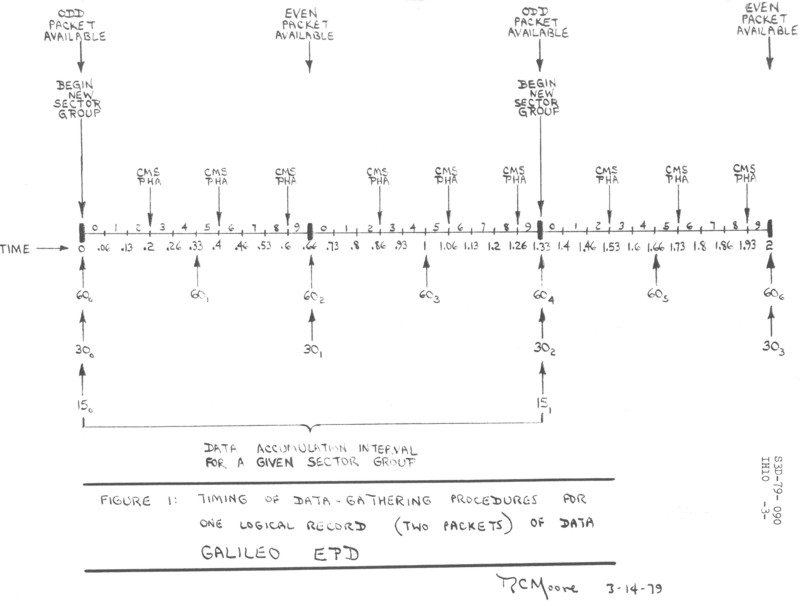The Galileo Energetic Particles Detector
Galileo EPD Handbook
Chapter 1. Instrument Summary
Galileo EPD Telemetry Packet Formats
Source: R. C. Moore, August 9, 1979
Each packet of EPD telemetry contains seventy-six bytes of data. Two successive packets constitute a "logical record." Each logical record has the same format as every other logical record, except for subcommutated data (such as housekeeping/status and singles/background).
The following tables give a bit-by-bit description of the packet formats for one logical record.
Every thirteenth packet, when byte 9 bits 5-8 are all zero, a LEMMS PHA spectrum will have just been accumulated (during the previous 2/3 second interval). Because the LEMMS PHA and the CMS PHA share the same A/D converter, there will be no CMS PHA data in those packets where byte 9 bits 5-8 are all zero. Instead, bytes 10-21 will contain the A/E/F LEMMS PHA identifier code bits and the values of the two scaling constants, K1 and K2, used in generating the spectrum.
There are 7 rate channel fields designated as "Singles/Background" channels. Their names (in the packet format tables) are SB0 through SB6. The singles rate channels (JaS, JbS, JcS, AS, BS, CD, DS, KS, and LS) and the background rate channels (EB1, EB2, FB1, and FB2) are subcommutated into the seven singles/background rate channel fields, using three different formats, as shown in the following table:
|
Singles/Background Rate Channels |
|||||||
| SB0 | SB1 | SB2 | SB3 | SB4 | SB5 | SB6 | |
| Format L | AS | BS | CS | DS | EB1 | EB2 | FB2 |
| Format J | AS | LS | JaS | JcS | KS | JbS | FB1 |
| Format J' | AS | BS | Ja'S | Jc'S | K'S | EB2 | FB1 |
When the singles/background flag (byte 8, bit 7) is "zero," format L applies for the entire logical record. When the singles/background flag (byte 8, bit 7) is "one," either format J or format J' applies for the entire logical record, depending on the state of the J/J' indicator (byte 8, bit 8). If the J/J' indicator is "zero," format J applies. If the J/J' indicator is "one," format J' applies.
In EPD modes where only one end of the CMS telescope is being used, the format for singles/background data will alternate between format L and format J or J', depending on the end of the CMS being used. (Byte 8, bit 8 indicates which end of the CMS is being used.) In the "CMS alternate" mode, in which the end of the CMS telescope being used changes after each logical record, the singles/background format sequence is as follows:
...L, J, J', L, J', J, L, J, J', L, J', J, ...
In the packet format tables, each rate channel name and PHA data record name is tagged in parentheses with the time at which the data were gathered. This time is relative to the contents of the spacecraft clock ("t") which appears in the header for the low-rate science data frame in which that particular packet will reside. If a particular rate channel data field is tagged with "(t-2/3)", for example, and the data field contains rate channel data that are sampled every 2/3 second ("30-sector" data), then that piece of data was accumulated over the time interval from t-4/3 to t-2/3. Figure 1 illustrates some of the timing relationships among the various types of rate channels and the CMS PHA data gathering activities. Notice that in the second ("odd") packet the value of the variable "t" is 2/3 greater than for the first ("even") packet.
Figure 1. Timing of data-gathering procedures for one logical record (two packets) of data.

Next: R. C. Moore memo dated Aug. 13, 1979
Return to Galileo EPD Handbook Table of Contents Page.
Return to main
Galileo Table of Contents Page.
Return to Fundamental
Technologies Home Page.
Updated 8/23/19, Cameron Crane
QUICK FACTS
Mission Duration: Galileo was planned to have a mission duration of around 8 years, but was kept in operation for 13 years, 11 months, and 3 days, until it was destroyed in a controlled impact with Jupiter on September 21, 2003.
Destination: Galileo's destination was Jupiter and its moons, which it orbitted for 7 years, 9 months, and 13 days.



